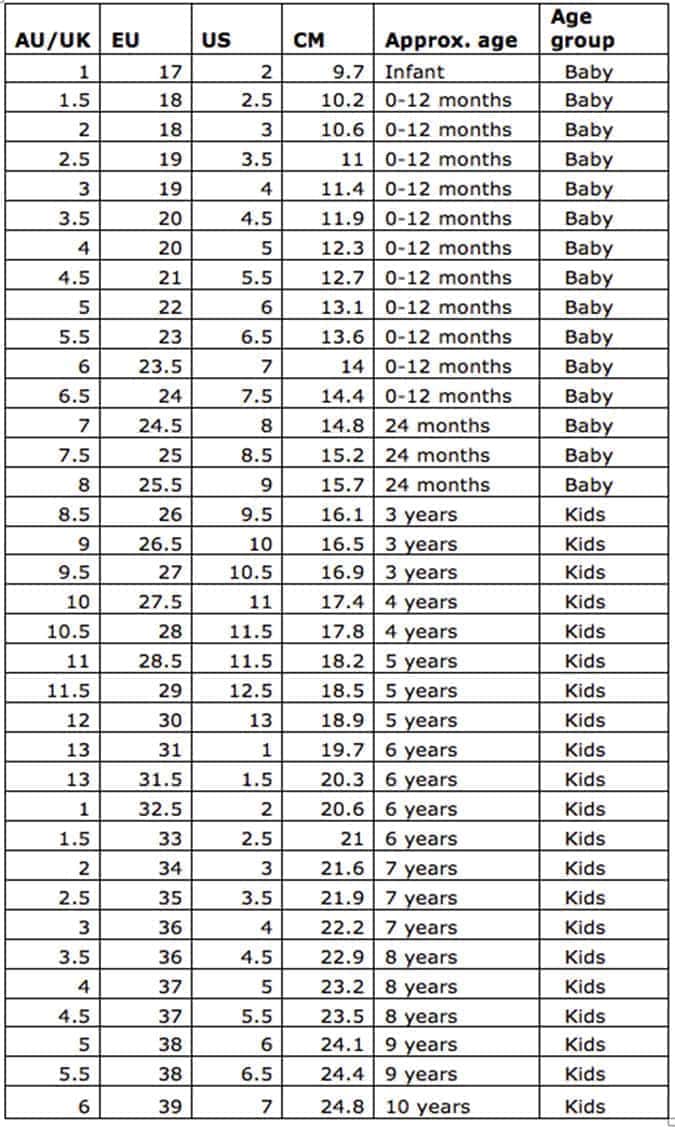Mastering The Australian Kids Shoe Size Chart: A Comprehensive Guide for Parents
Greetings, Super Parents! We know shopping for your child’s shoes can often seem like a tough challenge. Size discrepancies, especially with different international size charts, often make the process overwhelming. No worries though! We’re here to help you decipher the Australian Kids Shoe Size Chart, ensuring your little one’s feet are comfortably and stylishly clad no matter where you’re buying their shoes.
Understanding the Australian Shoe Size System
The Australian shoe sizing system can be mystifying, particularly if you’re used to UK or US sizes. But don’t worry, we will illuminate every tiny (pun intended!) aspect of it in clear, easy-to-understand terms.
Conversion: Australian Kids Shoe Sizes to US and UK Sizes
Getting the conversion right is key to ensuring you pick the right shoes for your kiddies. Whether you’re ordering online from an oversea store or you’re travelling, we’ve got you covered with our conversion guide.
The Importance of a Proper Fit
Before we delve into the specifics of Australian shoe sizes, we must stress the impression of a well-fitting shoe on your child’s growing feet. Ill-fitted shoes may hinder their natural growth and development. Hence, we urge you to pay vital attention to this aspect.
Decoding the Australian Kids Shoe Size Chart
Next, we’ll discuss the specifics of Australian shoe sizes. From infants to young children, the Australian size chart varies. We will illustrate this using a comprehensive size chart and examples for a clearer perspective.
Measurement Techniques For the Perfect Fit
Once you’ve gained some understanding about the Australian shoe sizes, we’ll show you how to accurately measure your child’s feet at home. This will make your online or in-store shopping experience more straightforward and hassle-free.
To all our caring parents, sit back, relax, and let us walk you through this journey (literally!). By the end of this guide, you’ll be quite the expert – and you’ll relish in knowing your child’s feet are correctly supported in their Aussie-sized shoes!

Breaking Down the Size Chart: Infants and Toddlers
For the tiny tots, shoe sizes start from size 0 and go up to size 5. This range generally fits infants of 0-1 years. A size 0 corresponds to 7.3 centimetres in length, and a size increase would mean approximately an additional 0.6-0.8 centimetres.
Youth Sizes: Growing Kids and Adolescents
You’re not alone if you’ve wondered why Australian size 6 sneakers seem bigger than adult size 6. It’s because the kids’ shoe sizing switches once more after size 13, and it kicks off again at size 1. Youth sizes typically range from 1-6 for kids aged 2-12 years.
Measuring Your Child’s Feet Accurately
Don’t fret if you feel lost already. With the right techniques, you can easily measure your child’s feet at home.
Tools You Will Need
Not much, really! Just a pen, a piece of paper, a ruler or measuring tape, and of course, your child’s little foot!
The Measuring Process
1. Have your child stand on a paper, ensuring that their foot is flat and fully stretched.
2. Mark the base of the heel and the tip of the longest toe with a pen.
3. Measure the distance between these two points in centimetres using your measuring tool.
4. This length in centimetres corresponds to the shoe size on the Australian kids shoe size chart.
Quick Tips For a Great Fit
Always remember to consider room for growth, especially for fast-growing youngsters. A thumb-width extra at the toe is a good fit. Pay attention to width as well as length; some shoe brands offer different width fittings. Lastly, ensure the shoes fit well from the get-go; they should not need a ‘break-in’ period.
Wrapping it Up
And there you have it, dear parents, a handy guide to help you navigate the world of Australian Kids shoe sizes. So, take a deep breath, equip yourself with this guide, and embark on that all-important shoe shopping spree for your little ones. Happy shopping!
Preparing for an Australian Kids Shoe Size Chart
Understanding the Size Chart Differences
Firstly, parents should understand that Australian shoe sizes are different from American, UK and European sizes. Always ensure to use a chart specifically designed for Australian sizes to reduce chances of error when purchasing your child’s footwear.
Measure Your Child’s Foot
As kids grow quickly, it’s crucial to measure their feet before making any shoe purchases. Use a ruler, brannock device, or printable foot measuring guide to correctly measure your child’s foot size. Always measure feet in the afternoon as they slightly swell by the end of the day, offering a more accurate shoe size.
Consider your Child’s Age
Although age is a rough guide, it can give parents a starting point when determining shoe sizes. In Australia, toddler shoe sizes typically range from 0-13, while children’s sizes range from 1-6
Understanding the Shoe Size Chart
Australian shoe size charts follow a simple calculation; the shoe size in Australia is equivalent to foot length in centimeters plus two. Grasping this numbering system would help in making the right selection.
Allow Room for Foot Growth
Children’s feet grow at a fast pace. Always allow a bit of room for growth when choosing shoe sizes. A fit that’s just right at purchase time may become tight within a few months, so consult with professionals or experienced parents for advice.
Remember that the comfort of your child’s feet is paramount in their ability to explore the world with more freedom and joy!
For more great articles please see here. For more information see here
Disclaimer
The articles available via our website provide general information only and we strongly urge readers to exercise caution and conduct their own thorough research and fact-checking. The information presented should not be taken as absolute truth, and, to the maximum extent permitted by law, we will not be held liable for any inaccuracies or errors in the content. It is essential for individuals to independently verify and validate the information before making any decisions or taking any actions based on the articles.




